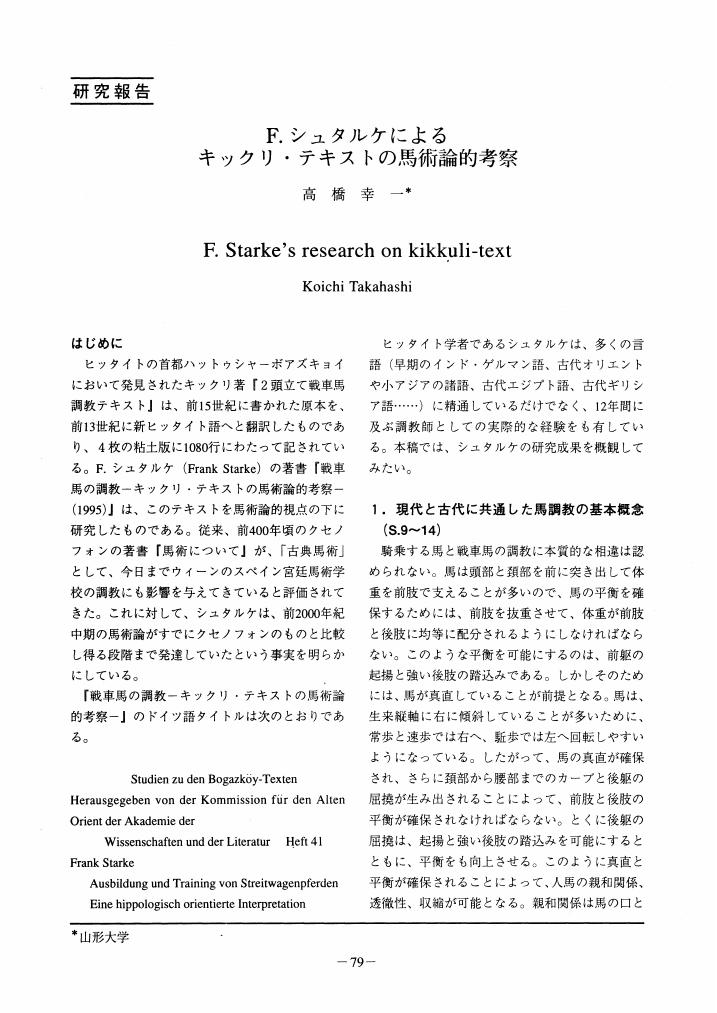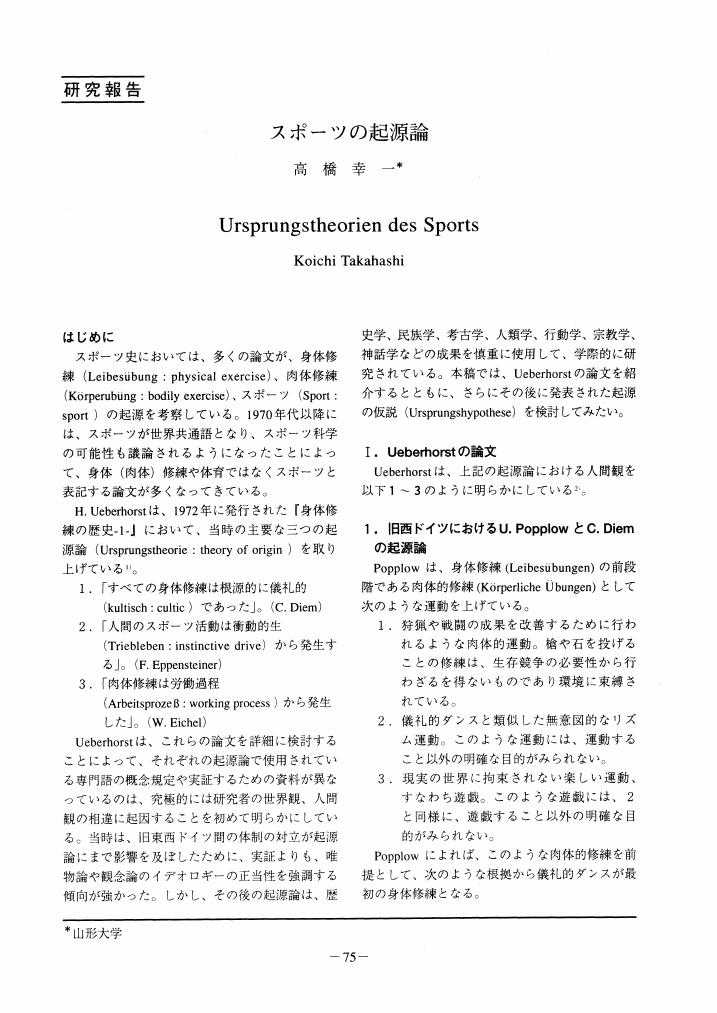7 0 0 0 OA F.シュタルケによるキックリ・テキストの馬術論的考察
- 著者
- 高橋 幸一
- 出版者
- Japan Society of Sport Anthropology
- 雑誌
- スポーツ人類學研究 (ISSN:13454358)
- 巻号頁・発行日
- vol.1999, no.1, pp.79-88, 1999-12-01 (Released:2011-06-08)
- 参考文献数
- 1
- 被引用文献数
- 1 1
5 0 0 0 OA 古代世界における女性とスポーツ
- 著者
- 高橋 幸一
- 出版者
- 一般社団法人 日本体育・スポーツ・健康学会
- 雑誌
- 体育学研究 (ISSN:04846710)
- 巻号頁・発行日
- vol.56, no.1, pp.19-30, 2011 (Released:2011-07-08)
- 参考文献数
- 40
- 被引用文献数
- 1 2
In recent decades, much evidence for women's sports in the ancient world has been uncovered. In ancient Greece, men concentrated on politics, wars, athletics, and the like, whereas desirable womanly qualities were considered to be beauty, modesty and obedience. Accordingly, no women's events were included in the ancient Olympic Games. It is said that married women were not allowed to be present at Olympia during the games, although unmarried women were permitted to watch the games. Except in militaristic Sparta, athletics were usually for male citizens. However, in the festivals of Hera, only girls could compete in foot-races. Like the boys, Spartan girls paraded naked in the presence of the men and participated in foot-races, wrestling, discus and javelin. Tryphosa, but also her two sisters, competed in and won foot-races in several major athletic festivals, but not at Olympia. Although married women could not compete in the Olympics, they could win Olympic victories in the equestrian events. Thus it is certain that women did participate in athletics. This paper examines the participation of women in sports at the Olympic Games and the festivals of Hera. Except for the priestess of Demeter Chamyne, married women were forbidden to attend the Olympics as spectators. Unmarried women and girls were also excluded from watching the games. In order to prevent bribery, trainers had to present themselves naked and undergo physical examinations. Unmarried women competed every four years in foot-races at the festivals of Hera held at Olympia. Some have suggested that the Heraian games became Panhellenic, but there is no historic evidence for this. The local festivals in which only women and girls were able to participate took place separately from the Olympics. Kyniska of Sparta was the first women's Olympic victor in the four-horse chariot race. Agesilaus persuaded his sister Kyniska to enter a chariot race at Olympia and showed that Olympic chariot victories could be won by wealth and not by manly courage. However, it is certain that Kyniska was exceedingly ambitious to enter the Olympic Games, winning twice in all. However Kyniska's victories did not lead to the spreading of women's sports or to improvement of women's rights.
2 0 0 0 OA スポーツの起源論
- 著者
- 高橋 幸一
- 出版者
- Japan Society of Sport Anthropology
- 雑誌
- スポーツ人類學研究 (ISSN:13454358)
- 巻号頁・発行日
- vol.2000, no.2, pp.75-85, 2001-01-31 (Released:2011-06-08)
- 参考文献数
- 28
2 0 0 0 古代世界における女性とスポーツ
- 著者
- 高橋 幸一
- 出版者
- 一般社団法人 日本体育学会
- 雑誌
- 体育学研究 (ISSN:04846710)
- 巻号頁・発行日
- vol.56, no.1, pp.19-30, 2011
- 被引用文献数
- 2
In recent decades, much evidence for women's sports in the ancient world has been uncovered. In ancient Greece, men concentrated on politics, wars, athletics, and the like, whereas desirable womanly qualities were considered to be beauty, modesty and obedience. Accordingly, no women's events were included in the ancient Olympic Games. It is said that married women were not allowed to be present at Olympia during the games, although unmarried women were permitted to watch the games. Except in militaristic Sparta, athletics were usually for male citizens.<br> However, in the festivals of Hera, only girls could compete in foot-races. Like the boys, Spartan girls paraded naked in the presence of the men and participated in foot-races, wrestling, discus and javelin. Tryphosa, but also her two sisters, competed in and won foot-races in several major athletic festivals, but not at Olympia. Although married women could not compete in the Olympics, they could win Olympic victories in the equestrian events. Thus it is certain that women did participate in athletics. This paper examines the participation of women in sports at the Olympic Games and the festivals of Hera.<br> Except for the priestess of Demeter Chamyne, married women were forbidden to attend the Olympics as spectators. Unmarried women and girls were also excluded from watching the games. In order to prevent bribery, trainers had to present themselves naked and undergo physical examinations. Unmarried women competed every four years in foot-races at the festivals of Hera held at Olympia. Some have suggested that the Heraian games became Panhellenic, but there is no historic evidence for this. The local festivals in which only women and girls were able to participate took place separately from the Olympics.<br> Kyniska of Sparta was the first women's Olympic victor in the four-horse chariot race. Agesilaus persuaded his sister Kyniska to enter a chariot race at Olympia and showed that Olympic chariot victories could be won by wealth and not by manly courage. However, it is certain that Kyniska was exceedingly ambitious to enter the Olympic Games, winning twice in all. However Kyniska's victories did not lead to the spreading of women's sports or to improvement of women's rights.<br>
1 0 0 0 OA 近世医療文化財の普遍的価値創成:『薬箱』の包括的保存技術の確立と実践
日本薬物文化の意義を明確にするため、自国の医療・社会環境に則して成熟してきた近世医療文化財(緒方洪庵使用薬箱他)の普遍的価値をマテリアルサイエンス導入による文理融合型手法で立証した。本草考証と非侵襲/微量分析法の構築が、医療文化財遺物分析を可能にし、実体物から生薬品質の暗黙知が解明できることを示唆した。人工ミュオンビームを初めて医療文化財分析に適用し、同一測定法で外部の容器と内部の薬物双方の元素組成分析に成功したことで、新規非破壊分析法としての人工ミュオンビームの有用性を明らかにした。
1 0 0 0 OA ミケーネ文明におけるスポーツ
- 著者
- 高橋 幸一
- 出版者
- スポーツ史学会
- 雑誌
- スポーツ史研究 (ISSN:09151273)
- 巻号頁・発行日
- vol.29, pp.1-14, 2016 (Released:2017-06-08)
It can no longer be believed that the Greeks were unique in their agonal spirit. Many scholars argue that competition is typical of ancient societies. The purpose of this paper is to examine sport in the Mycenaean civilization. However, it is necessary to clarify whether the Minoans influenced the Mycenaean sports. Minoan civilization The Minoans mainly practiced bull leaping and boxing. Bull leaping in particular was the most popular sport among the Minoans. The noble participants had to leap over bulls. Though it is supposed that the bull leaping is, like boxing, a kind of competitive sport, there is no certain evidence. On the other hand, the boxers weared a metal helmet protecting the head and face. The purpose of this dangerous boxing is uncertain. We cannot clearly decide whether the boxing and bull leaping are initiation ritual, or secular activity. Some scholars believe that the Minoan sport influenced the Myceaean and Greek sports. The Mycenaeans adopted only the bull sport. The helmeted boxers and bull leaping are unknown in Greek art. Mycenaean civilization Many archaeological evidences confirm the existence of horse-drawn chariots in the ancient Near East, but they were used in war and hunting. Although F. Starke’s new interpretation of the Kikkuli Text was accepted by a few scholars, he wrongly interpreted the Text. Hittites did not enjoy chariot racing. It seems to be possibility that chariot racing was performed by the Myceaeans. However, a few archeological evidences only suggest the sport. The issues of prizes remain unsolved. It is not clear whether the Mycenaean chariot racing influenced Homer. It is clear that sports were part of the funeral ceremony held in honor of the dead. It seems to be reasonable to suppose that the Mycenaeans had funeral games with armed combat, bull leaping and possibly chariot racing. However, some scholars argue that boxing and bull leaping are not funeral game, but initiation ritual in the Aegean civilization. It is the present conditions that opinions about sports in the Mycenaean civilization are argued variously because there is no certain evidence.
- 著者
- 宇多 高明 三波 俊郎 高橋 幸一 蛸 哲之 石川 仁憲
- 出版者
- 公益社団法人 土木学会
- 雑誌
- 土木学会論文集B2(海岸工学) (ISSN:18842399)
- 巻号頁・発行日
- vol.72, no.2, pp.I_751-I_756, 2016
- 被引用文献数
- 8
湘南海岸では,相模川河口テラスの縮小や,茅ヶ崎漁港およびヘッドランドの下手海岸での侵食など,土砂バランスの崩れによる地形変化が各所で起きている.本研究では,既往研究も踏まえてこれらの点について考察を深めたものであり,空中写真に基づく汀線変化解析と1999年以降取得されてきたNMB測量データに基づく地形変化解析を行った.これにより湘南海岸全体における土砂バランスの崩れによる地形変化の実態を明らかにし,その上で課題解決のための土砂管理法について論じた.
1 0 0 0 OA 漢方方剤の実践的応用:併用療法に役立つ薬物動態学的相互作用情報の重要性
- 著者
- 高橋 京子 侯 暁瓏 高橋 幸一
- 出版者
- 公益社団法人 日本薬理学会
- 雑誌
- 日本薬理学雑誌 (ISSN:00155691)
- 巻号頁・発行日
- vol.132, no.5, pp.270-275, 2008 (Released:2008-11-14)
- 参考文献数
- 22
- 被引用文献数
- 2 1
東西医薬品の併用投与は有効な治療手段となっているが,歴史的経験知は東西薬物併用療法を想定していなかったため,適正使用に必要な情報が著しく不足している.最適な併用療法の実践には,安易な漢方薬の使用中止ではなく,薬物動態学的相互作用情報の提供が求められる.CYP3A4はヒトチトクロムP450(CYP)に最も多く存在する分子種で,小腸には全体の30%程度が分布することから,経口剤の薬物動態学 的相互作用の主要な因子である.従来の生薬・漢方薬に関する相互作用報告は統一的見解に至らず,結果の相違が生薬の多様性や実験動物の種差などで処理されている.そこで,動物実験の利点と限界を理解し,目的に応じた評価系構築を提案する.その目的は,(1)漢 方方剤(漢方薬)の総合的評価,(2)薬物代謝酵素CYP450とP-glycoproteinに対する影響,(3)漢方薬の服用方法(経口剤・前処置・連続投与)に則した実験法の構築,(4)薬物動態学的パラメーターの算出,(5)相互作用発現機序を検証できることである.まず,著者らは,雄性ラットに柴苓湯(さいれいとう)(蒼朮(そうじゅつ)配合)を反復前処置することで惹起される消化管CYP3A代謝変動を,ニフェジピンの体内動態パラメーターから解析した.その変動を肝臓および小腸ミクロソームのCYP3A活性,関連タンパクの発現状態,相互作用の持続性について検討し相互作用発現機序に至る過程を明らかにした.また,柴苓湯による異なる相互作用報告は,製造企業間で素材生薬(日本薬局方収載の蒼朮または白朮(びゃくじゅつ)配合)や混合比率の相違のため比較が困難で,生薬製剤の品質が重要な課題となることを再確認した.一方,柴苓湯の含有成分パターンから,高濃度を占めるバイカリンなどの配糖体由来成分の動態は,腸内細菌などの生体の反応性に左右される.漢方薬の真価を評価し適正使用を推進するためには,同じ規格毎の方剤で科学的エビデンスが蓄積され,情報発信ができることを切望する.
1 0 0 0 古代世界における女性とスポーツ
- 著者
- 高橋 幸一
- 出版者
- Japan Society of Physical Education, Health and Sport Sciences
- 雑誌
- 体育学研究 (ISSN:04846710)
- 巻号頁・発行日
- vol.56, no.1, pp.19-30, 2011
- 被引用文献数
- 2
In recent decades, much evidence for women's sports in the ancient world has been uncovered. In ancient Greece, men concentrated on politics, wars, athletics, and the like, whereas desirable womanly qualities were considered to be beauty, modesty and obedience. Accordingly, no women's events were included in the ancient Olympic Games. It is said that married women were not allowed to be present at Olympia during the games, although unmarried women were permitted to watch the games. Except in militaristic Sparta, athletics were usually for male citizens.<br> However, in the festivals of Hera, only girls could compete in foot-races. Like the boys, Spartan girls paraded naked in the presence of the men and participated in foot-races, wrestling, discus and javelin. Tryphosa, but also her two sisters, competed in and won foot-races in several major athletic festivals, but not at Olympia. Although married women could not compete in the Olympics, they could win Olympic victories in the equestrian events. Thus it is certain that women did participate in athletics. This paper examines the participation of women in sports at the Olympic Games and the festivals of Hera.<br> Except for the priestess of Demeter Chamyne, married women were forbidden to attend the Olympics as spectators. Unmarried women and girls were also excluded from watching the games. In order to prevent bribery, trainers had to present themselves naked and undergo physical examinations. Unmarried women competed every four years in foot-races at the festivals of Hera held at Olympia. Some have suggested that the Heraian games became Panhellenic, but there is no historic evidence for this. The local festivals in which only women and girls were able to participate took place separately from the Olympics.<br> Kyniska of Sparta was the first women's Olympic victor in the four-horse chariot race. Agesilaus persuaded his sister Kyniska to enter a chariot race at Olympia and showed that Olympic chariot victories could be won by wealth and not by manly courage. However, it is certain that Kyniska was exceedingly ambitious to enter the Olympic Games, winning twice in all. However Kyniska's victories did not lead to the spreading of women's sports or to improvement of women's rights.<br>
1 0 0 0 プラトンの『ゴルギアス』における強壮
- 著者
- 高橋 幸一
- 出版者
- スポーツ史学会
- 雑誌
- スポーツ史研究 (ISSN:09151273)
- 巻号頁・発行日
- no.20, pp.117-123, 2007-03-15

